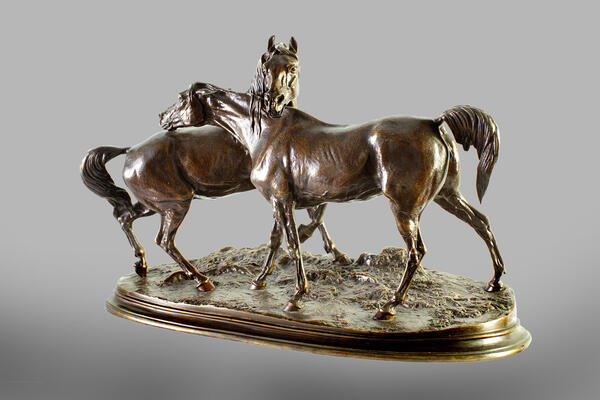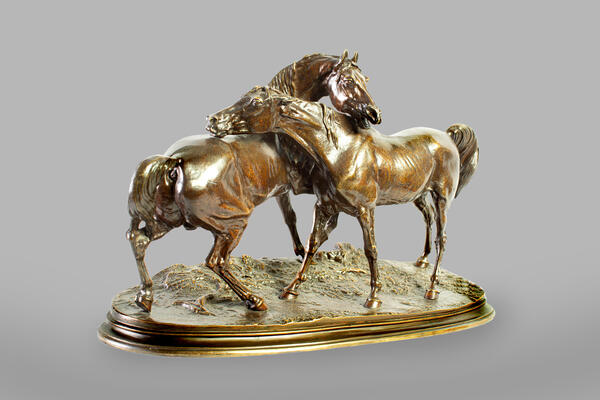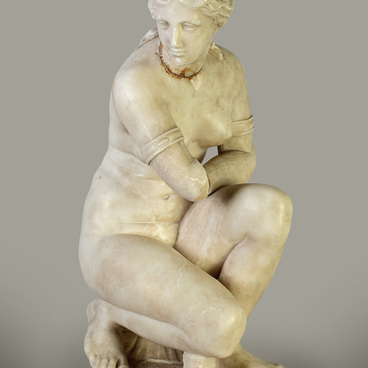The museum houses a sculpture called “Passion (Horses)” that was created by one of the representatives of the animalier school — Pierre-Jules Mêne (1810–1879). The animalier school, which began with the famous Antoine-Louis Barye (1795–1875), became widespread in French sculpture in the 19th century.
Pierre-Jules Mêne was born in Paris in 1810 into the family of a foundry worker. The boy studied under his father and learned various metalworking techniques. Mêne began to create small sculptures as early as his childhood years. The future sculptor did not receive any special education in any of the famous schools, however, he did receive some training from the sculptors René Compère and Antoine-Louis Barye while in Paris. Like many other famous sculptors, Mêne began his career by making various decorative models for porcelain makers; he also created artistic designs for clocks and took small commissions for bronze works. In 1837, Mêne established his first foundry, and in 1838, he made his debut at the famous Paris Salon, where he received critical acclaim and universal recognition. Mêne shared the realistic approach the Barbizon painters had toward nature and worked on simple everyday subjects, revealing the hidden poetry of the world.
Mêne’s composition “Passion” fascinates with the way the relationship of the animals is humanized, conveying the expression of such sentiments as maternal tenderness, sentimentality, and affection. The works of the sculptor enjoyed great success in Russia. Mêne’s models were used to make castings in the town of Kasli in the Urals. The copy of the presented sculpture is housed in the Kyiv State Museum of Western and Eastern Art. A similar composition called “Horses in the Wild” by the famous sculptor Pyotr Klodt was cast in Kasli in 1915. The fact that the work had this many counterparts can be explained by the tradition that existed from the second half of the 19th century to the early 20th century when the introduction of some minor changes to the known composition of some sculptor made it an independent work of another creator.
Pierre-Jules Mêne was born in Paris in 1810 into the family of a foundry worker. The boy studied under his father and learned various metalworking techniques. Mêne began to create small sculptures as early as his childhood years. The future sculptor did not receive any special education in any of the famous schools, however, he did receive some training from the sculptors René Compère and Antoine-Louis Barye while in Paris. Like many other famous sculptors, Mêne began his career by making various decorative models for porcelain makers; he also created artistic designs for clocks and took small commissions for bronze works. In 1837, Mêne established his first foundry, and in 1838, he made his debut at the famous Paris Salon, where he received critical acclaim and universal recognition. Mêne shared the realistic approach the Barbizon painters had toward nature and worked on simple everyday subjects, revealing the hidden poetry of the world.
Mêne’s composition “Passion” fascinates with the way the relationship of the animals is humanized, conveying the expression of such sentiments as maternal tenderness, sentimentality, and affection. The works of the sculptor enjoyed great success in Russia. Mêne’s models were used to make castings in the town of Kasli in the Urals. The copy of the presented sculpture is housed in the Kyiv State Museum of Western and Eastern Art. A similar composition called “Horses in the Wild” by the famous sculptor Pyotr Klodt was cast in Kasli in 1915. The fact that the work had this many counterparts can be explained by the tradition that existed from the second half of the 19th century to the early 20th century when the introduction of some minor changes to the known composition of some sculptor made it an independent work of another creator.





